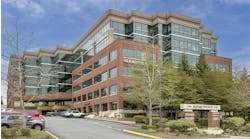ST. LOUIS — When a group of progressive design professionals reclaimed an old structure in the Grove District of St. Louis, they vaulted beyond their comfort zone when choosing energy systems. Mechanically speaking, what they chose is everything under the sun.
SPACE Architecture + Design is an architectural firm that has recommended use of renewable energy sources for indoor comfort. So, when they designed and crafted their very own space, they decided to install a geothermal system and rooftop solar arrays as the source of space and domestic water heating, with ample cooling, too.
SPACE principal Tom Niemeier wanted building systems to be a reflection of the firm’s own forward-thinking perspective, so they dug deeper, and sought additional tax incentives to help fund building-wide use of radiant floor heat and suspended, exposed chilled beams for cooling, solar heat to drive desiccant dehumidification, and integration of fresh air.
System integration
Two system needs were quickly apparent. Given the plan for substantial use of geothermal energy, SPACE would need a geoexchange field. Heat load calculations showed that the building’s cooling system would require 15 grouted boreholes, each 200-ft. deep.
Next up: how to put the systems together in a way that would successfully integrate all functions and components? Neimeier tapped the resources and expertise of Uli Altvater, P.E., chief technology officer of Naples, Fla.-based FutureWorld Energy Inc., and Ron Oliver, vice president of Masters Equipment, based in St. Louis.
Together they began to map out a renewable energy strategy. Oliver then traveled to the AHR Expo in 2010 to research a controls strategy that could integrate all system components.
“I left there knowing exactly what we needed to bring Neimeier’s dream into reality,” said Oliver. “I was introduced to Taco’s just-introduced, modular iWorx controls and was amazed by the simplicity, scalability and the affordability of the technology. We were also glad to learn that it would soon be available through Behrmann Co., our local Taco rep in St. Louis.”
Through Walt Steiner, P.E., president of St. Louis-based Behrmann Co., the long-time manufacturer’s rep for Taco, Oliver quickly learned that their use of the control platform at SPACE would become the very first commercial application of the technology.
“One of our top sales engineers, Dave Westbrook, worked with Ron Oliver to design a relatively simple control strategy that would meet the needs at SPACE,” said Steiner. “With so many pieces to the mechanical puzzle there, we needed exactly what iWorx offered, and yet with no need for fixed-cost firmware."
“The project was very interesting for us from the outset,” said Steiner. “The mechanical recipe that Tom Neimeier wanted to use was not a cost-driven one. Up front, they developed a plan that entailed the integration of many systems, knowing clearly that they would spend more on it than what would be required for a traditional HVAC approach. They made it clear that energy efficiency, then comfort, were more important than overall cost.”
The primary source of heat for the water that flows through the building’s radiant heat system are the 15 solar thermal vacuum tube arrays mounted on the roof of the one-story building. Heat from the rooftop arrays is transported below to an insulated, 3,000-gal. storage tank buried below the parking lot.
“The primary use of solar heat was a good concept from the beginning,” Ron Oliver added. “Then, with that as the foundation, the plan grew to include geothermal. With geo producing both hot and cold water, the plan could include radiant cooling with exposed cooling fins suspended throughout the building’s interior spaces, something the SPACE pros enjoyed because they became intriguing design elements.”
The plan then grew to include integration of fresh air intake and desiccant wheel technology to control interior moisture, then using warmth from the solar thermal arrays to remove moisture from the desiccant wheel.
Chillin’ in Missouri
The radiator-like, chilled plates are part of an innovative heating and cooling system that now helps SPACE use 51% less energy than a similar facility built to code standards. During the summer, the solar arrays provide heat for the desiccant wheel to dehumidify building air. Coupled with the geothermal system’s ability to produce chilled water to cool the air, it will keep occupants comfortable on hot, humid days.
The cooling system works by taking heat out of the air rather than pushing cool air into the room. Cold water running through the pipes absorbs heat from air that flows by the fins. Designers relied on the chimney effect that keeps warmer air rising to flow through the fins. The water then carries heat back to the geothermal wells under the parking lot where heat is dispersed.
“We achieved very high system efficiency levels because of the influence of all the systems,” Altvater explained. “With radiant floor circulation temperatures of only 89°F-94°F, tied to outdoor reset, the mechanical systems at SPACE run at optimal efficiency.”
The geothermal system is operating consistently at heating and cooling COPs of 7 to 9. For cooling, Altvater explained that 55°F-58°F water is circulated through the fins, just above dewpoint. Dehumidification is accomplished with the NovelAire desiccant wheel with two heat exchangers sandwiched on either side of the wheel. Super-heated water from the solar arrays is circulated within one of the heat exchangers to dry trapped moisture within the wheel. The other heat exchanger, which circulates chilled water to extract latent heat, is activated whenever necessary to maintain a zero-energy gain within the building envelope.
According to Altvater, the solar thermal arrays are producing 35-kW of power, equivalent to 120,000 Btuh for building heat as the primary source, with the geothermal heat pump as the back-up system. During the summer months, solar heat at 150°F-200°F is sent directly to the 3,000-gal. thermal mass tank, then on to the desiccant wheel heat exchanger to remove moisture suspended in the wheel at a rate of up to 18-lbs./hr.
“Clearly, we needed to remove sensible heat,” said Oliver. “Yet, there was no moisture removal with the fins. With the desiccant wheel sandwiched between the hot water and chilled water coils, we could remove moisture and regenerate the wheel.”
According to Oliver, the chilled water coil cools the discharge air going back to the building envelope to achieve a net-zero energy gain.
“The chilled fins, unlike a fan coil unit, provide no latent removal of moisture, so this became a viable way to condition the space,” added Oliver.
Controls to the rescue
The key challenges to optimizing operation of the multiple SPACE systems were the needs to sensibly integrate all components, and to do so in a way that maximized operational efficiency.
“The owners wanted complete Internet access without complex gateways or PCs and iWorx fit the application perfectly,” said Oliver.
"The fact that we could use a standard controller to control the chilled fin ceiling as well as the geothermal equipment was a huge, cost advantage. What makes it so cost effective is that there are no control sequences to write and all the software is already built into the controls. It worked perfectly right out of the box and at a small fraction of the cost of other BAS products."
“What surprised me was how easily it tied so many system components together,” said Steiner. “We see opportunities every day to design projects with solar heat, geothermal or chilled beam cooling, but the uniqueness of the SPACE application was to incorporate them all.”
SPACE’s radiant heating and cooling zones are individually controlled by electronically operated mixing valves for both cooling and heating. The control system is capable of taking multiple temperature inputs and controlling each zone’s electronically operated valve, satisfying individual setpoints. It also aggregates zone demands to eliminate equipment short cycling. Load inputs include individual zone response to setpoint, supply temperature and outdoor temperature. Precise zone control assures that radiant heating and cooling systems provide comfort under any climatic condition.
Injection mixing
Taco’s mixing control module provides injection mixing for both heating and cooling with individual reset curves for heating and cooling modes. In addition, the unit provides dew point control to prevent condensation during cooling periods in the summer months.
“By precisely adjusting the voltage output to the mixing valve, we were able to provide a very short stroke range to control supply temperatures within 10ths of a degree,” said Oliver.
Monitoring system performance assures proper system operation and control. Operation of the solar array and other critical system functions are monitored by the control system, which provides up to eight inputs and also constant monitoring of the measured points, and alarms.
Important to system performance is the control of geothermal system components. The controller responds to indoor and outdoor temperatures to control the radiant heating system. Since the heating system also has a solar thermal array, heat input from the solar thermal arrays is also calculated and controlled.
Related Articles:
Geothermal system helps home achieve net-zero energy usage
Related Articles:
Geothermal installation is educational process for contractors




